|
Carrot Preparation | Carrot Cooking | Tips
| Carrots |
|

A plant of the parsley family with feathery green leaves and an orange root that can be eaten raw or cooked. The most commonly found carrots generally have a long, narrow, cylindrical cone shape root, but they are also found in other varieties that may be thick and short in shape, or that are purple, yellow, or white in color. The carrot has a sweet flavor and is one of the most popular versatile root vegetables. Carrots may range in length from 2 inches to 2 or 3 feet but are generally 8 to 9 inches in length when harvested to sell as fresh market carrots. More mature carrots are used for processing. Carrots are high in sugar and fiber and are an excellent source of carotene, which gives the carrots their bright orange color. Carrots are also a good source of other nutrients, such as potassium, calcium, magnesium, vitamin A, and folic acid. |
| Uses:
Carrots can be eaten raw or cooked. Raw carrots are eaten as a snack, or an appetizer, and are sliced, chopped, or grated to add to salads. They can be cooked using many different methods, such as boiling, steaming, sautéing, roasting or grilling. When cooked, carrots are eaten as a side dish on their own or cooked with other vegetables. They are also often added to other dishes, such as stir fries, casseroles, quiches, omelets, soups, and stews. The sweet flavor of carrrots also makes them a popular ingredient in baking cakes, muffins, breads, and cookies. |
|
At Their Best:
Carrots are available all year round in food stores but when growing them, they do best in cool weather. Plant in early spring so they are ready to harvest before the hottest days of summer, or plant late summer after the hottest period and harvest in the fall. |
|
How to Buy:
When selecting, look for carrots that are uniform in color from top to bottom and whose skin is smooth and free of cracks. The carrots may be slightly green at the crown but a dark coloring at the crown indicates that the carrots are getting old. Generally the carrots found readily available are long and slender but there are also varieties that are short and fat. Whatever variety is being purchased, all the carrots should be uniform in size, shape and color. When selecting carrots that still have the stems attached, select those that have fresh looking greens. Avoid carrots that have begun to sprout, that have blemishes, soft spots, or large green areas at the crown, and any that have become limp. |
| Storage:
Carrots can be stored in the refrigerator for up to a month if stored properly. To prevent condensation from forming, wrap the carrots in a paper towel and then place them in a bag in the refrigerator, or use a perforated plastic bag. Excess moisture will cause them to rot. If the carrots still have the greens attached, cut them off 2 inches above the crown to prevent them from drawing moisture out of the carrots. Do not store carrots next to ethylene gas producing fruits, such as apples and pears. The ethylene gas they release speeds up the ripening process of other fruits and vegetables. Carrots can also be stored unwashed and covered by sand. If stored in this manner in a dark, cool, well ventilated area, the carrots will last up to 5 or 6 months. They can also be left in the ground, covered with mulch, and used as needed until the ground begins to freeze. Carrots can also be peeled, cut up, blanched, and then frozen to preserve them for approximately a year. |
| Varieties: |
|
Imperator
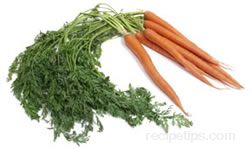
|
Long, thin, tapered carrots that are a rich orange color. The different varieties range in length from 8 to 11 inches. Imperators are the type of carrot most often found fresh in food stores. They are also used to produce mini-peeled carrots. |
| Nantes |
A medium length carrot whose different varieties range from 6 to 8 inches in length. It has a deep orange color and are generally the same diameter from top to bottom with a blunt tip. They have a higher water content than other carrots, which causes them to loose their shape when cooked. Their core is less fibrous, so they are more tender and sweeter in flavor, making the a good eating carrot. They are used for slicing and mini-peeled carrots. |
| Danvers |
A medium length carrot whose different varieties range from 7 to 8 inches in length. They are slightly tapered but are thicker than Imperators and have a blunt end. Danvers have a nice orange color and are a good eating carrot. They can be found sold in fresh markets and they are also used in processing. |
| Chantenay |
A short, thick carrot that is slightly tapered with a blunt end. They are approximately 5 inches in length and are slightly lighter orange in color. Chantenay carrots have a sweet flavor but their texture is coarser than some of the other types of carrots. These carrots are primarily used in processing diced carrots. |
|
Maroon Carrots
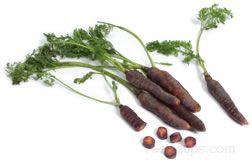
|
A variety of carrot that is distinctive in color and nutritional properties. This carrot has a purple or maroon outer coloring with an orange or orange and maroon colored inner flesh. The carrot provides a slightly sweeter apple-like flavor and contains higher levels of anthocyanins (purple pigments) that act like antioxidants, providing a healthy food alternative and a natural source of beta carotene. The maroon carrot can be prepared for juices, desserts, sauces, appetizers, side dishes, and for adding to other foods. |
|
True Baby Carrots
|
True baby carrots are small, sweet and tender carrots that are harvested earlier than normal. They are generally sold with their greens still on and they look like a normal carrot only smaller. They are not cut and peeled in the same manner as mini-peeled carrots. |
|
Mini-Peeled Carrots
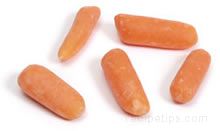
|
Mini-peeled carrots are most often labeled as baby carrots but they are not true baby carrots. They are actually a long, thin variety of carrot that is grown close together and bred to ripen faster than other varieties. After being harvested, they are washed and cut into 2-inch pieces. They are then sent through cutters and peelers to shape and polish them to their finished size. Min-peeled carrots have become very popular as a snack, appetizer, and for cooking because of the convenience in not having to cut and peel them before using. |
Carrot Preparation
Cleaning | Remove Core | Cutting | Julienne Carrots | Grated Carrots
Carrot preparation involves very basic procedures. They only require cleaning, peeling, and cutting to desired size. Small, young carrots and baby carrots do not need to be peeled but older carrots and those with surface blemishes should be peeled.
Cleaning Carrots
| Gently scrub carrots under cold running water to remove all the dirt on the surface. Do not wash until ready to use. Store unwashed. |
 |
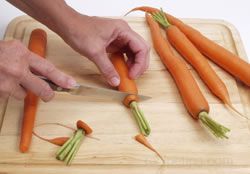 |
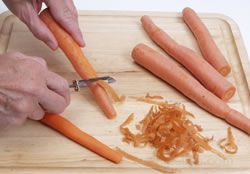 |
| Trim the ends of the carrots. Peel carrots if desired. To peel, use a vegetable peeler and trim thin slices lengthwise from the surface until the entire surface is peeled. Peel only one layer from the surface. If the carrots have a bad spot on them, remove it by cutting it out with a small knife. |
Removing the Carrot Core
The core of older and larger carrots can sometimes be woody. It is best to remove them from the carrot before using.
| Cut carrot into 2 to 2 1/2 inch sections and cut the sections in half lengthwise. Cut the halves lengthwise again to form 2 wedges. If the carrot is fairly wide, cut it into 3 wedges. |
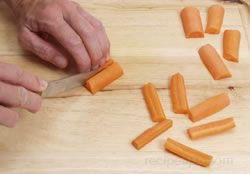 |
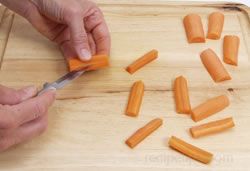 |
 |
| Using a small sharp knife, cut along both edges of the lighter colored core and snap out the core. Finish cutting as desired. |
Cutting Carrots
Carrots can be cut into many different shapes and sizes. How the carrots are cut will depend on their end use and personal preference. Shown below are some of the common cuts used when preparing carrots.
|

|
 |
|
Carrot Sticks
Cut carrots into 2 to 2 1/2-inch sections. Cut sections in half or into quarters, depending on desired thickness of the sticks. Sections from the narrow end may not need to be cut and sections from the thickest end may need to be into more than quarters. This will depend on the thickness of the carrot and personal preference.
|
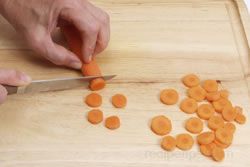 |
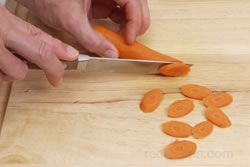 |
|
Carrot Rondelles (Rounds)
Cut across carrots to create slices of desired thickness. Keep all slices to the same thickness.
|
Carrot Ovals
Cut across carrots with the knife at an angle to form oval shaped slices. |
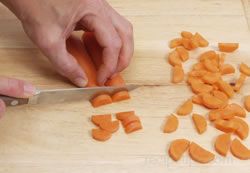 |
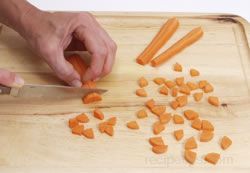 |
|
Carrot Half-rounds
Cut carrots in half lengthwise. Lay carrots with flat side down and cut crosswise to the desired thickness. |
Carrot Triangles
Cut carrots in half lengthwise and cut each half into 2 or 3 wedges. Cut wedges crosswise to desired thickness.
|
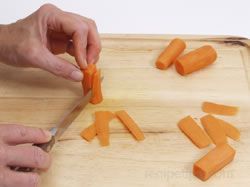 |
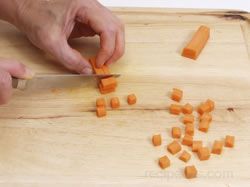 |
|
Diced Carrots
Cut carrots into 2-inch long sections. Square sections by cutting lengthwise slices from the sides, creating four sides to the carrot. Cut carrots crosswise to the same thickness as the width of the squared carrot to form a cube. For smaller cubes, slice squared carrot sections into quarters before cutting into cubes. |
Julienne Carrots
| Begin with a clean, peeled carrot. Slice four sides of the carrot to create a rectangle. |
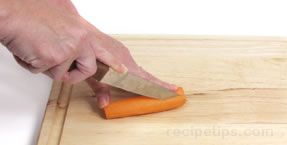 |
| Cut squared carrots into sections that are the desired length of the finished julienned carrot. |
 |
| Cut each section of carrot lengthwise into approximately 1/8 inch thick slices. |
 |
| Stack the 1/8 inch slices and again, cut lengthwise at approximately 1/8-inch to form the julienne carrot strips. |
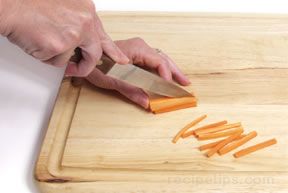 |
Grated Carrots
Grated carrots add color, flavor, and nutrition to the food it is added to. They are used in salads, soups, sauces, and baked goods. Carrots can be grated by a hand grater, food processor, or blender. Before grating, clean carrots, trim ends, and peel if desired.
|
Hand Grater
To grate by hand, hold grater in one hand and the carrot in the other. Rub the carrot downward on the side of the grater with the appropriate sizes holes for the desired coarseness of the grated carrots. Be careful to keep hands and fingers away from the grater. Throw end of carrot away when it cannot be held on to securely while grating. |
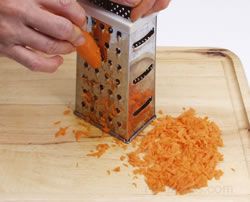 |
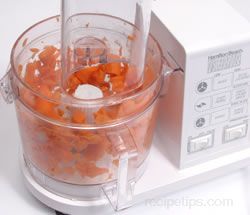 |
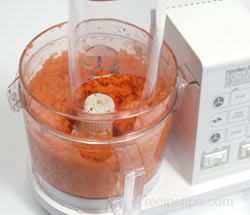 |
|
Food Processor
Carrots can be quickly grated in a food processor. Cut carrots into smaller pieces before placing in the processor. Place the pieces in the processor, attach cover securely, and turn on processor. Stop processor often to check coarseness of grated carrots. Remove from processor when carrots are grated to desired coarseness. Watch carrots closely to avoid grating them too fine. |
Carrot Cooking
Steam | Boil | Braise | Roast | Sauté / Stir-Fry | Microwave
Carrots can be eaten raw or cooked, but cooking carrots brings out their natural sweetness. Cooking carrots also breaks down the fiber in beta-carotene, making it more usable to the body. Carrots can be cooked using several methods. Some common methods are steaming, boiling, braising, roasting, sautéing, stir frying, and microwaving. Carrots should be cooked only until they are tender-crisp to ensure maximum flavor. Overcooking may also destroy some of the nutrients contained in carrots. It is important that the carrots, whether they are whole, sticks, slices, or diced cubes, are uniform size pieces to allow them to cook evenly.
Steam:
Boil:
|
Bring salted water to a boil in a saucepan. Add carrots to the water, allow the water to begin boiling again, and cook at a simmer. |
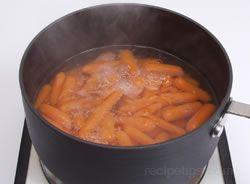 |
| Allow baby carrots to cook for approximately 8 to 10 minutes and slices or smaller pieces for 5 to 10 minutes. Drain carrots and prepare for serving. |
 |
Braise:
|
Add 3 tablespoons of stock (or water) and 2 tablespoons of butter per pound of carrots to the pan and heat until liquid begins to simmer. Add carrots to the pan. |
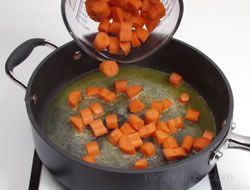 |
| Cover and cook carrots over medium heat for 5 minutes. |
 |
|
Remove cover and boil until remaining liquid evaporates. Serve carrots while hot. |
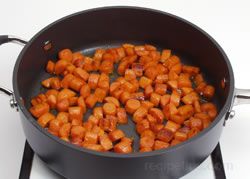 |
Roast:
|
Cut carrots in half lengthwise and then into 1 1/2 inch pieces. |
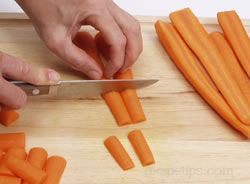 |
| Place on a baking sheet and lightly coat with oil. Season with salt and pepper. |
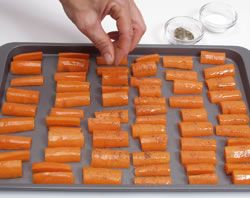 |
|
Bake in the oven at 400°F for 20 to 30 minutes until carrots are tender-crisp and lightly browned. Serve while hot. |
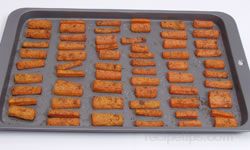 |
Sauté / Stir-Fry:
When sautéing or stir-frying, it is a good idea to parboil the carrots first so they are partially cooked ahead of time. This will allow them to be cooked to the proper doneness when sautéed or stir-fried with other ingredients that are faster cooking. If they are being sautéed or stir-fried on their own, be sure they are thinly sliced so that they will cook properly without burning. Cook in half margarine and half oil over moderately high heat. Mixing butter with oil will help prevent margarine from burning. Stir frequently to prevent carrots from burning. Cook just until tender-crisp.
Microwave:
Cut carrots into slices or 1-inch pieces and place in a microwave safe dish. Add approximately 3 tablespoons of water per pound of carrots. Cover and cook on high for 10 to 12 minutes. Stir once through cooking time. Leave covered and allow to stand for 3 to 4 minutes. Serve while hot.
Tips
- Cooking carrots will bring out their natural sweetness.
- When cooking carrots be sure to cut the pieces as close as possible to the same size so that they will cook evenly.
- Enhance the naturally sweet flavor of carrots by adding a little honey or sugar when cooking.
- When cutting pieces or slicing carrots, cut diagonally to expose more surface. This will allow the carrot to cook more quickly.
- Carrots that have become limp can be soaked in ice water to make them crisp again.
- Peeled carrots will sometimes develop a dry, white coating when being stored. If they seem to be acceptable otherwise, the carrots can be rehydrated by soaking in cold water for a short period of time. This should rid the carrots of the white coating and bring them back to their original color.
- One pound of fresh carrots equals 6 to 8 medium carrots, 24 to 34 baby carrots, 2 1/2 cups shredded, and 3 cups sliced or chopped.
|

